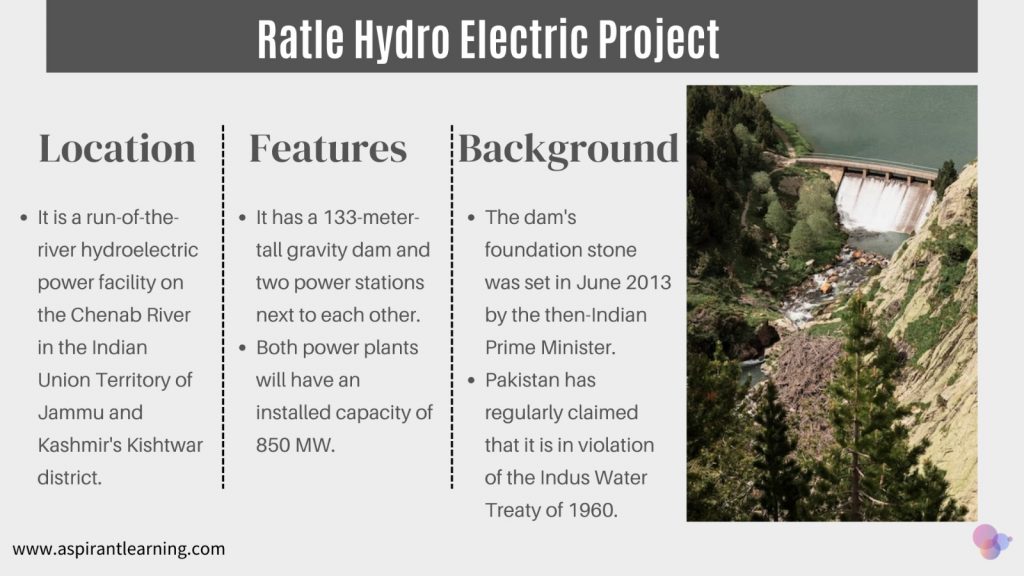News Highlight
India sends notice to Pakistan to amend the 1960 Indus Water Treaty.
Key Takeaway
- On January 27, India declared its intention to amend the 62-year-old Indus Water Treaty (IWT) with Pakistan.
- It cited Pakistan’s “intransigence” in resolving disputes over the Kishenganga and Ratle hydropower projects, both located in Jammu and Kashmir.
- Furthermore, India objected to Pakistan’s “unilateral” decision to seek arbitration at The Hague.
Indus Water Treaty (IWT)
- Key Provisions
- The Indus river system comprises the main Indus River, Jhelum, Chenab, Ravi, Beas, and Sutlej.
- The basin is primarily shared by India and Pakistan, with China and Afghanistan having a minor share.
- The waters of three rivers, the Ravi, Sutlej, and Beas, were allotted to India for exclusive usage in a treaty between India and Pakistan in 1960.
- While the waters of the Western rivers, Indus, Jhelum, and Chenab, were allotted to Pakistan.
- Under the Treaty, India was permitted to use them for specific residential, non-consumptive, and agricultural purposes.
- India has also been granted the right to create hydroelectricity through run-of-river (RoR) projects on the Western Rivers, subject to particular design and operating conditions.
- It was necessary for both countries to form a Permanent Indus Commission comprised of permanent commissioners from both sides.
- The commission will serve as a venue for exchanging river information, for ongoing cooperation, and as the first point of contact for conflict resolution.
- The Indus river system comprises the main Indus River, Jhelum, Chenab, Ravi, Beas, and Sutlej.
Issues With Indus Water Treaty Between India And Pakistan
- Firstly, the Indus Water Treaty between India and Pakistan raises several difficulties.
- Pakistan expressed complaints during the Tulbul Project, causing it to be halted in 1987.
- Another point of contention with the Indus River Treaty is that it was signed by the then-PM of India rather than the then-President of India.
- In addition, Pakistan established the LOBD [Left Bank Outfall Drain] project without the agreement of Indian officials.
- It flows from Gujarat’s Rann of Katch and threatens floods in the surrounding areas.
- Moreover, India has objected, claiming that it violates the IWT.
Present Developments in the Indus Water treaty
- To utilise the waters of the Eastern rivers that have been allotted to India for exclusive use, the following dams have been built:
- Bhakra Dam on Satluj,
- Pong and Pandoh Dam on Beas and
- Thein (Ranjit Sagar) on Ravi.
- Other projects, like the Beas-Sutlej Link, Madhopur-Beas Link, Indira Gandhi Nahar Project, etc., have assisted India in using virtually all (95%) of the waters of Eastern rivers.
- However, it is reported that approximately 2 million acre-feet (MAF) of water from Ravi is still flowing unutilised to Pakistan below Madhopur each year.
- The subsequent efforts have been taken to halt the flow of these Indian waters for use in India:
- Shahpurkandi Project
- Construction of Ujh multipurpose project
- The 2nd Ravi Beas link below Ujh
- Additionally, the three projects listed above will assist India in utilising its share of the waters granted under the Indus Waters Treaty of 1960.

Way Forward
- Firstly, India should take steps to utilise its entitlement to the waters of Western Rivers completely.
- The infrastructure to utilise the waters has remained underdeveloped in J&K.
- Some experts believe that if Pakistan escalates its hostilities in the future, India should stop the meetings of the Permanent Commission.
- If the initial state of dispute resolution is not operational, the second two steps of three-tier dispute resolution do not take effect.
- As a result, India might utilise this as a kind of pressure on Pakistan.
- In addition, India should consider using climate change as a “change in circumstances” to discuss renegotiating the IWT.
- The standing committee on water resources recommends renovating the canal systems in Punjab and Rajasthan to boost their water-carrying capacity.
Pic Courtesy: The Hindu
Content Source: The Hindu



